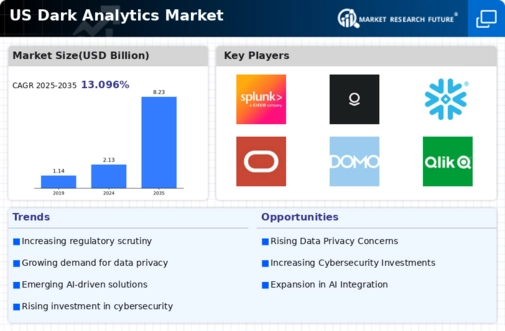Emergence of Data-Driven Cultures
The emergence of data-driven cultures within organizations is a significant driver of the dark analytics market. As businesses increasingly prioritize data as a strategic asset, there is a growing recognition of the need to analyze all available data, including unstructured sources. This cultural shift encourages organizations to adopt dark analytics solutions that can provide deeper insights and foster innovation. Companies that embrace data-driven decision-making are likely to outperform their competitors, with studies indicating that data-driven organizations achieve 5-6% higher productivity. As this trend continues to gain momentum, the dark analytics market is expected to flourish, driven by the demand for comprehensive data analysis capabilities.
Growing Need for Enhanced Decision-Making
the dark analytics market is seeing increased demand as organizations aim to improve decision-making.. Companies are increasingly recognizing the value of unstructured data, which often contains critical insights that traditional analytics overlook. This shift is driven by the need for more informed strategies and operational efficiencies. In fact, a recent study indicates that organizations leveraging dark analytics can improve decision-making speed by up to 30%. As businesses strive to remain competitive, the dark analytics market is poised for growth, with projections suggesting a compound annual growth rate (CAGR) of 15.08% over the next five years.. This trend underscores the importance of harnessing hidden data to drive strategic initiatives.
Increased Focus on Operational Efficiency
The dark analytics market is significantly influenced by organizations' heightened focus on operational efficiency. Companies are increasingly turning to dark analytics to identify inefficiencies and optimize processes. By analyzing unstructured data, businesses can uncover hidden patterns and insights that lead to improved resource allocation and cost savings. This trend is particularly evident in sectors such as manufacturing and logistics, where operational efficiency is paramount. A recent report suggests that organizations utilizing dark analytics can achieve cost reductions of up to 20%. As the demand for streamlined operations continues to rise, the dark analytics market is expected to expand, providing solutions that drive efficiency and productivity.
Regulatory Compliance and Risk Management
The dark analytics market is also shaped by the growing emphasis on regulatory compliance and risk management. Organizations are increasingly required to adhere to stringent regulations regarding data usage and privacy. Dark analytics offers a means to navigate these complexities by providing insights into data governance and compliance. Companies can leverage dark analytics to identify potential risks and ensure adherence to regulations, thereby mitigating legal and financial repercussions. The market is likely to see a rise in demand for solutions that facilitate compliance, with estimates suggesting a growth rate of 18% in this segment over the next few years. This focus on compliance underscores the critical role of dark analytics in modern business practices.
Advancements in Data Processing Technologies
Technological advancements are playing a pivotal role in the evolution of the dark analytics market. Innovations in data processing technologies, such as natural language processing (NLP) and advanced machine learning algorithms, enable organizations to extract valuable insights from vast amounts of unstructured data. These technologies facilitate the analysis of text, images, and other non-traditional data formats, which were previously challenging to interpret. As a result, businesses are increasingly investing in dark analytics solutions to unlock the potential of their data assets. The market is projected to reach a valuation of $5 billion by 2027, reflecting the growing recognition of the importance of advanced analytics in driving business success.
























Leave a Comment